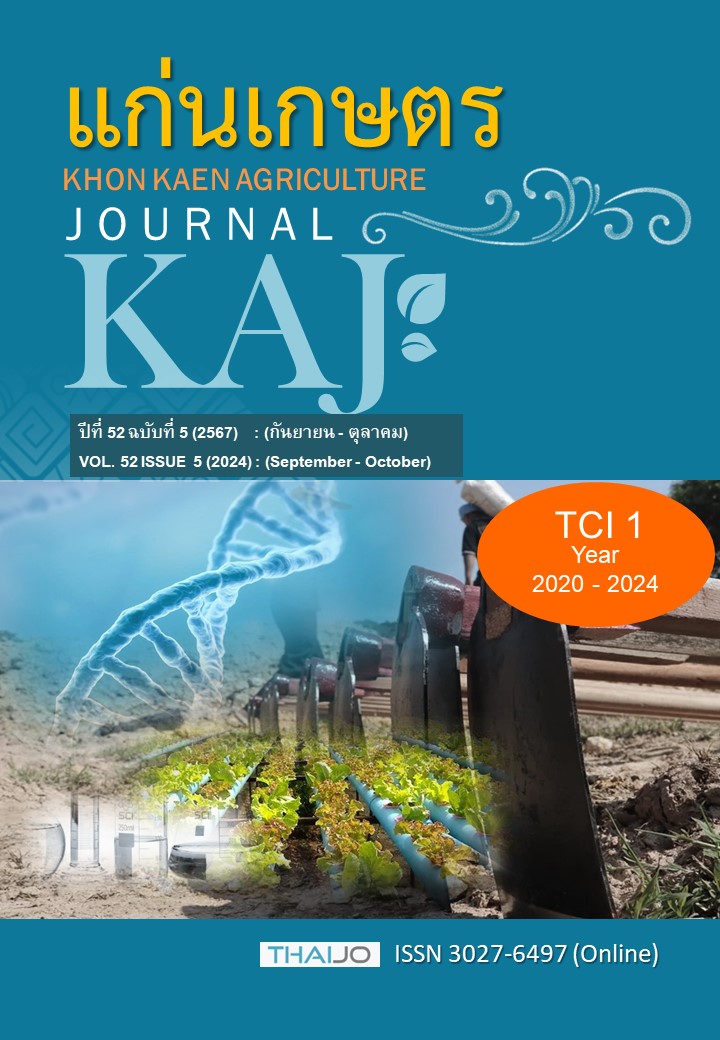การตอบสนองของต้นอ่อนวงศ์กะหล่ำต่อสเปกตรัมแสงแอลอีดี
Main Article Content
บทคัดย่อ
ผักต้นอ่อนมีคุณค่าอาหารมากกว่าผักชนิดเดียวกันที่โตเต็มที่แล้วจึงเป็นที่นิยมบริโภคของผู้รักสุขภาพและเริ่มมีการผลิตในระบบปิดโดยใช้แสงจากหลอดแอลอีดี ซึ่งสเปกตรัมแสงเป็นปัจจัยสำคัญที่มีผลต่อการเจริญเติบโตและคุณภาพของผลผลิตที่ปลูกภายใต้แสงเทียม ดังนั้น การศึกษานี้จึงมีวัตถุประสงค์เพื่อศึกษาอิทธิพลของสเปกตรัมแสงต่อการเจริญเติบโตและการสร้างสารสำคัญที่มีคุณค่าทางโภชนาการของต้นอ่อนบร็อคโคลี อะรูกูล่า และกะหล่ำปมม่วง แยกเป็น 3 การทดลองสำหรับต้นอ่อนแต่ละชนิด แต่ละการทดลองใช้แผนการทดลองแบบสุ่มสมบูรณ์ จำนวน 3 ซ้ำ มีกรรมวิธีเป็นแสงแอลอีดีที่มีความยาวคลื่นแสงต่างกัน 6 สเปกตรัม ได้แก่ สีขาว สีแดง สีน้ำเงิน และสีแดงต่อน้ำเงินสัดส่วน 2:1, 1:1 และ 1:2 ตามลำดับ ทุกสเปกตรัมแสงควบคุมให้มีความเข้มแสงช่วง PPFD เท่ากับ 150 µmol·m–2·s–1 นาน 12 ชั่วโมงต่อวัน ควบคุมอุณหภูมิอากาศในห้องปลูกที่ 25 °C ความชื้นสัมพัทธ์และความเข้มก๊าซคาร์บอนไดออกไซด์ในห้องปลูกมีค่าอยู่ในช่วง 65–80% และ 350±50 ppm ตามลำดับ เก็บเกี่ยวต้นอ่อนที่อายุ 12 วันหลังเพาะเมล็ด พบว่า สำหรับต้นอ่อนทุกชนิด แสงสีแดงให้ความสูง น้ำหนักสดและน้ำหนักแห้งต่อต้นสูงกว่าสเปกตรัมแสงอื่น แสงสีขาวส่งเสริมการสร้างคลอโรฟิลล์ สเปกตรัมแสงที่สีน้ำเงินในสัดส่วนที่สูงส่งเสริมการสร้างวิตามิน ซี และปริมาณสารต่อต้านอนุมูลอิสระดีดีพีเอช และสเปกตรัมแสงที่ส่งเสริมการสร้างแคโรทีนอยด์และสารฟีนอลิกสำหรับต้นอ่อนแต่ละชนิดมีความแตกต่างกันออกไป
Article Details

อนุญาตภายใต้เงื่อนไข Creative Commons Attribution-NonCommercial-NoDerivatives 4.0 International License.
เอกสารอ้างอิง
ภัทระ แสงไชยสุริยา, บังอร เทพเทียน, ปาริชาติ จันทร์จรัส, ภูษิต ประคองสาย, กุมารี พัชนี และปิยะฉัตร ตระกูลวงษ์. 2563. รายงานโครงการทบทวนสถานการณ์และผลการดำเนินงานป้องกันควบคุมโรคไม่ติดต่อเรื้อรังในประเทศไทย พ.ศ. 2560–2562 เสนอต่อ กองโรคไม่ติดต่อ กรมควบคุมโรค. แหล่งข้อมูล: https://ddc.moph.go.th/uploads/publish/1036320200810073233.pdf. ค้นเมื่อ 13 พฤษภาคม. 2566.
ปิยาภรณ์ วรานุสันติกูล, สุชาดา โทผล, เจษฎา แพนาค, นิวัฒน์ กังวานรังสรรค์ และศรีสุดา หาญภาคภูมิ. 2559. การศึกษาการต้านอนุมูลอิสระของสารสกัดหยาบจากสาบเสือ. วารสารวิจัยมหาวิทยาลัยสวนดุสิต สาขาวิทยาศาสตร์และเทคโนโลยี. 9(2): 31–58.
ศูนย์วิจัยกสิกรไทย. 2560. แนวโน้มตลาดสินค้าอาหารสุขภาพ โอกาสและความท้าทายของผู้ประกอบการ SME. ธนาคารกสิกรไทย แหล่งข้อมูล: https://www.kasikornbank.com/th/business/sme/KSMEKnowledge/article/KSMEAnalysis/Documents/HealthyProduct.pdf. ค้นเมื่อ 13 พฤษภาคม 2566.
Bantis, F. 2021. Light spectrum differentially affects the yield and phytochemical content of microgreen vegetables in a plant factory. Plants. 10: 2182.
Brazaitytê, A., J. Miliauskienê, V. Vaštakaitê-Kairienê, R. Sutulienê, K. Laužikê, P. Duchovskis, and S. Małek. 2021. Effect of different ratios of blue and red LED light on Brassicaceae microgreens under a controlled environment. Plants. 10(4): 801.
Craver, J.K, J.R. Gerovac, R.G. Lopez, and D.A. Kopsell. 2017. Light intensity and light quality from sole–source light–emitting diodes impact phytochemical concentration within Brassica microgreens. Journal of the American Society for Horticultural Science. 142(1): 3–12.
Dereje, B., J.C. Jacquier, C.E. Kingston, M. Harty, and N. Harbourne. 2023. Brassica microgreens: phytochemical compositions, influences of growing practices, post–harvest technology, health, and food application. ACS Food Science and Technology. 3(6): 981–998.
Frede, K., M. Schreiner, and S. Baldermann. 2019. Light quality-induced changes of carotenoid composition in pak choi Brassica rapa ssp. Chinensis. Journal of Phytochemistry and Photobiology, B: biology. 193: 18–30.
Giuseppina, P, F. Orsini, S. Blasioli, A. Cellini, A. Crepaldi, I. Braschi, F. Spinelli, S. Nicola, J.A. Fernandez, C. Stanghellini, G. Gianquinto, and L.F. M. Marcelis. 2019. Resource use efficiency of indoor lettuce (Lactuca sativa L.) cultivation as affected by red: blue ratio provided by LED lighting. Scientific Reports. 9: 14127.
Holden, M. 1976. Chemistry and Biochemistry of Plant Pigments (Goodwin, T. W.), 2nd ed. Academic Press, New York, pp. 462–488.
Ilakiya, T., E. Parameswari, V. Davamani, and E. Prakash. 2020. Microgreens-combacting malnutrition problem. Research Today. 2(5): 110-112.
Kong, Y., S. Katherine, and Y. Zheng. 2020. Maximum elongation growth promoted as a shade-avoidance response by blue light is related to deactivated phytochrome: a comparison with red light in four microgreen species. Canadian Journal of Plant Science. 100: 314–326.
Kozai, T. 2013. Resource use efficiency of closed plant production system with artificial light: Concept, estimation and application to plant factory. Proceeding of Japan Academy, Ser. B 89 (2013).
Kozai, T., G. Niu, and M. Takagaki. 2016. Plant Factory: An Indoor Vertical Farming System for Efficient Quality Food Production. Academic Press., California, U.S.A.
Khwankaew, J., D.T. Nguyen, N. Kagawa, M. Takagaki, G. Maharjan, and N. Lu. 2018. Growth and nutrient level of water spinach (Ipomoea aquatica Forssk.) in response to LED light quality in a plant factory. Acta Horticulturae 1227: 653-660.
Larsen, D.H., H. Li, S. Shrestha, J.C. Verdonk, C.C.S Nicole, L.F.M. Marcelis, and E.J. Woltering. 2022. Lack of blue light regulation of antioxidants and chilling tolerance in basil. Frontiers in Plant Science. 13: 852654.
Lee, C.P., and G.C. Yen. 2006. Antioxidant activity and bioactive compounds of tea seed (Camellia oleifera Abel.) oil. Journal of Agricultural Food Chemistry. 54(3): 779-84.
Lobato, A.K.S, M.C. Goncalves-Vidigal, P.S.V. Filho, C.A.B. Andrade, M.V. Kvitschal, and C.M. Bonato. 2010. Relationships between leaf pigments and photosynthesis in common bean plants infected by anthracnose. New Zealand Journal of Crop and Horticultural Science. 38(1): 29-37.
Lobiuc, A., V. Vasilache, O. Pintili, T. Stoleru, M. Burducea, M. Oroian, and M.M. Zamfirache. 2017. Blue and red LED illumination improves growth and bioactive compound contents in acyanic and cyanic Ocimum basilicum L. microgreens. Molecules. 22(12): 2111.
Meas, S., K. Leungwilai, and T. Thongket. 2020. Enhancing growth and phytochemicals of two amaranth by LEDs light irradiation. Scientia Horticulturae. 265: 1–10.
Mosaleeyanon, K. 2021. Current situation, direction, policy support, and challenges of plant factories in Thailand. FFTC Agricultural Policy Platform. Available: https://ap.fftc.org.tw/article/2745. Accessed Jul. 20, 2023.
Nelson, J.A., and B. Bugbee. 2014. Economic analysis of greenhouse lighting: light emitting diodes vs. high intensity discharge fixtures. PLoS One. 9(6): e99010.
Pattison, P. M., J. Y. tsao, G. C. Brainard, and B. Bugbee. 2018. LEDs for photons, physiology, and food. Nature. 563: 493–500.
Qinglu, Y., Y. Kong, and Y. Zheng. 2020. Growth and appearance quality of four microgreen species under light–emitting diode lights with different spectral combinations. HortScience. 55(9): 1399–1405.
Roe, J.H., M.B. Mills, M.J. Oesterling, and C.M. Damron. 1948. The determination of diketo-L-gulonic acid, dehydro-L-ascorbic acid, and L-ascorbic acid in the same tissue extract by the 2,4-dinirophenylhydrazine method. Journal of Biological Chemistry. 174: 201–208.
Son, K.H., and M.M. Oh. 2015. Growth, photosynthetic and antioxidant parameters of two lettuce cultivars as affected by red, green, and blue light-emitting diodes. Horticulture, Environment, and Biotechnology. 56: 639-653.
Stutte, G.W., and S. Edney. 2009. Photoregulation of bioprotectant content of red leaf lettuce with light-emitting diodes. HortScience. 44: 79-82.
Wang, H., M. Gu, J. Cui, K. Shi, Y. Zhou, and J. Yu. 2009. Effects of light quality on CO2 assimilation, chlorophyll-fluorescence quenching, expression of Calvin cycle genes and carbohydrate accumulation in Cucumis sativus. Journal of Phytochemistry and Photobiology. B, Biology. 96: 30–37.
Xiao, Z., G.E. Lester, Y. Luo, and Q. Wang. 2012. Assessment of vitamin and carotenoid concentrations of emerging food products: edible microgreens. Journal of Agricultural Food Chemistry. 60: 7644–7651.


